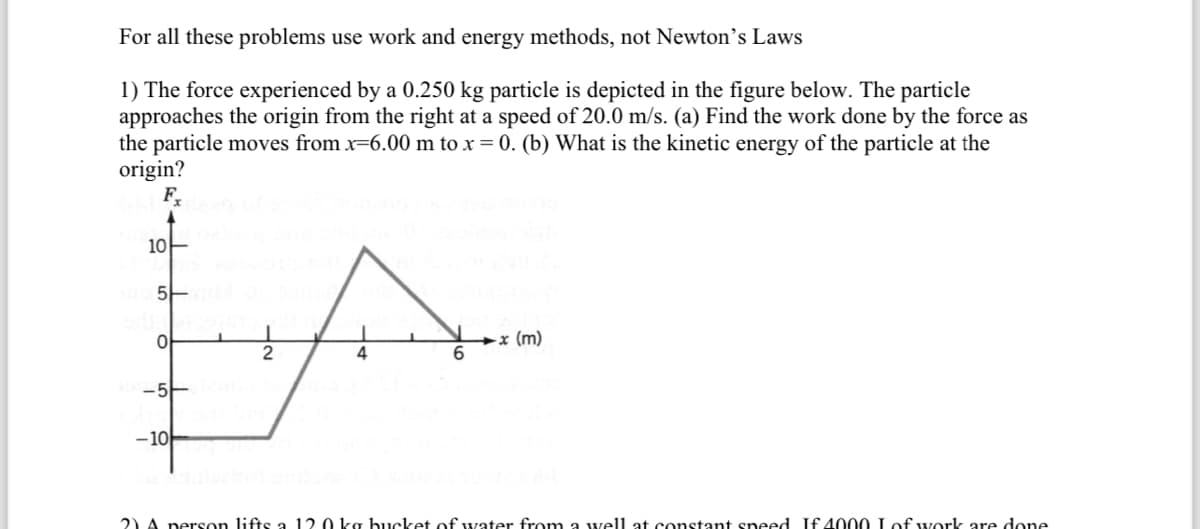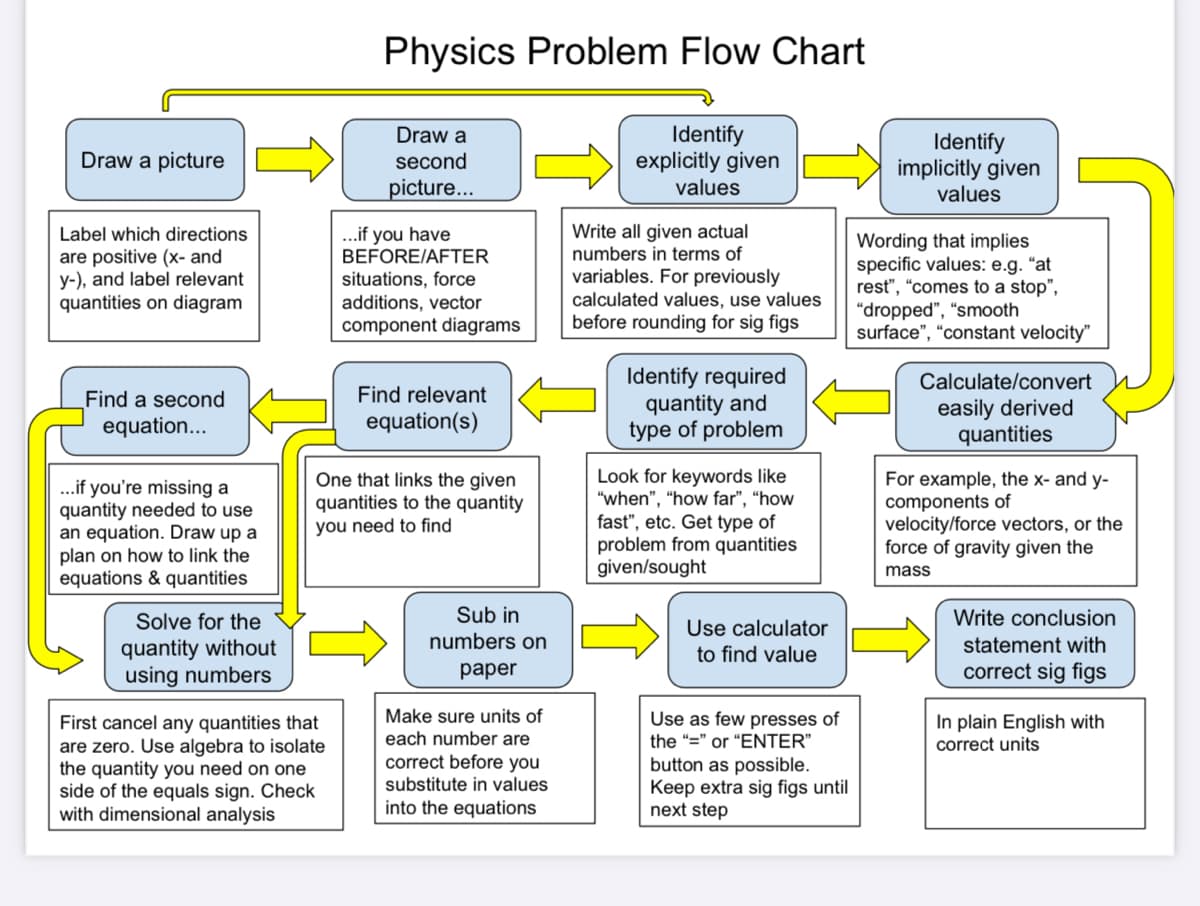1) The force experienced by a 0.250 kg particle is depicted in the figure below. The particle approaches the origin from the right at a speed of 20.0 m/s. (a) Find the work done by the force as the particle moves from x-6.00 m to x = 0. (b) What is the kinetic energy of the particle at the origin? F.
1) The force experienced by a 0.250 kg particle is depicted in the figure below. The particle approaches the origin from the right at a speed of 20.0 m/s. (a) Find the work done by the force as the particle moves from x-6.00 m to x = 0. (b) What is the kinetic energy of the particle at the origin? F.
College Physics
11th Edition
ISBN:9781305952300
Author:Raymond A. Serway, Chris Vuille
Publisher:Raymond A. Serway, Chris Vuille
Chapter5: Energy
Section: Chapter Questions
Problem 4P: a shopper in a supermarket pushes a cart with a force of 35 N directed at an angle of 25 below the...
Related questions
Topic Video
Question
For all these problems use work and energy methods, not Newton's Laws
1) The force experienced by a 0.250 kg particle is depicted in the figure below. The particle approaches the origin from the right at a speed of 20.0 m/s. (a) Find the work done by the force as
the particle moves from x=6.00 m to x = 0. (b) What is the kinetic energy of the particle at the
origin?
I need to draw picture and show all work

Transcribed Image Text:For all these problems use work and energy methods, not Newton's Laws
1) The force experienced by a 0.250 kg particle is depicted in the figure below. The particle
approaches the origin from the right at a speed of 20.0 m/s. (a) Find the work done by the force as
the particle moves from x-6.00 m to x = 0. (b) What is the kinetic energy of the particle at the
origin?
F
LA
2
4
10
5
-10
6
-x (m)
2) A person lifts a 120 kg bucket of water from a well at constant speed. If 4000 I of work are done

Transcribed Image Text:Draw a picture
Label which directions
are positive (x- and
y-), and label relevant
quantities on diagram
Find a second
equation...
...if you're missing a
quantity needed to use
an equation. Draw up a
plan on how to link the
equations & quantities
Solve for the
quantity without
using numbers
Physics Problem Flow Chart
Draw a
second
picture...
Identify
explicitly given
values
First cancel any quantities that
are zero. Use algebra to isolate
the quantity you need on one
side of the equals sign. Check
with dimensional analysis
...if you have
BEFORE/AFTER
situations, force
additions, vector
component diagrams
Find relevant
equation(s)
One that links the given
quantities to the quantity
you need to find
Sub in
numbers on
paper
Make sure units of
each number are
correct before you
substitute in values
into the equations
Write all given actual
numbers in terms of
variables. For previously
calculated values, use values
before rounding for sig figs
Identify required
quantity and
type of problem
Look for keywords like
"when", "how far", "how
fast", etc. Get type of
problem from quantities
given/sought
Use calculator
to find value
Use as few presses of
the "=" or "ENTER"
button as possible.
Keep extra sig figs until
next step
Identify
implicitly given
values
Wording that implies
specific values: e.g. "at
rest", "comes to a stop",
"dropped", "smooth
surface", "constant velocity"
Calculate/convert
easily derived
quantities
For example, the x- and y-
components of
velocity/force vectors, or the
force of gravity given the
mass
Write conclusion
statement with
correct sig figs
In plain English with
correct units
Expert Solution
This question has been solved!
Explore an expertly crafted, step-by-step solution for a thorough understanding of key concepts.
This is a popular solution!
Trending now
This is a popular solution!
Step by step
Solved in 5 steps with 6 images

Knowledge Booster
Learn more about
Need a deep-dive on the concept behind this application? Look no further. Learn more about this topic, physics and related others by exploring similar questions and additional content below.Recommended textbooks for you

College Physics
Physics
ISBN:
9781305952300
Author:
Raymond A. Serway, Chris Vuille
Publisher:
Cengage Learning

University Physics Volume 1
Physics
ISBN:
9781938168277
Author:
William Moebs, Samuel J. Ling, Jeff Sanny
Publisher:
OpenStax - Rice University

College Physics
Physics
ISBN:
9781285737027
Author:
Raymond A. Serway, Chris Vuille
Publisher:
Cengage Learning

College Physics
Physics
ISBN:
9781305952300
Author:
Raymond A. Serway, Chris Vuille
Publisher:
Cengage Learning

University Physics Volume 1
Physics
ISBN:
9781938168277
Author:
William Moebs, Samuel J. Ling, Jeff Sanny
Publisher:
OpenStax - Rice University

College Physics
Physics
ISBN:
9781285737027
Author:
Raymond A. Serway, Chris Vuille
Publisher:
Cengage Learning

Principles of Physics: A Calculus-Based Text
Physics
ISBN:
9781133104261
Author:
Raymond A. Serway, John W. Jewett
Publisher:
Cengage Learning

College Physics
Physics
ISBN:
9781938168000
Author:
Paul Peter Urone, Roger Hinrichs
Publisher:
OpenStax College

An Introduction to Physical Science
Physics
ISBN:
9781305079137
Author:
James Shipman, Jerry D. Wilson, Charles A. Higgins, Omar Torres
Publisher:
Cengage Learning